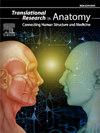原发性空蝶鞍尸体病例分析及空蝶鞍综合征的临床文献回顾
Q3 Medicine
引用次数: 0
摘要
空鞍解剖表现为垂体(垂体窝)紧贴鞍壁被压平。垂体畸形可引起许多神经系统和内分泌系统症状,导致空蝶鞍综合征(ESS),通常通过计算机断层扫描诊断,显示明显的“空蝶鞍”。大体的尸体成像和空鞍的组织学分析在文献中很少报道,但可能有助于了解这种情况。本研究的目的是通过大体影像、组织学分析和全面的临床回顾来研究一例完全性原发性空鞍(PES)的尸体病例。方法在对一具经伦理批准的捐献者老年男性尸体进行常规解剖时发现空鞍。该案件是从多个视点拍摄的。在中矢状面对头部进行切片,并用比例照相显示残余垂体的形态。在另一具具有典型垂体解剖结构的尸体上进行了一致的解剖,照片和测量,以进行并排比较。对压缩后的垂体进行组织学分析,并进行光镜检查。结果该空蝶鞍病例的大体检查显示特征性完全性PES,是由经蝶鞍膈塌陷的脑脊液(CSF)疝引起。尽管垂体体积明显压缩和缩小,但其组织组织和细胞特征仍与典型垂体组织保持比例一致。尸体的年龄(90岁以上)和性别(男性)是独特而有价值的临床讨论。结论:本病例对一例空蝶鞍病例进行了全面的分析,包括大体解剖照片、组织学检查,并全面回顾了一例老年男性个体完全性PES罕见的临床意义。本报告为解剖学家、神经学家、内分泌学家和医学教育者提供了关于空鞍临床意义的重要临床见解。本文章由计算机程序翻译,如有差异,请以英文原文为准。
Cadaveric case analysis of primary empty sella with clinical literature review of empty sella syndrome
Introduction
An empty sella anatomical finding is characterized by the pituitary gland (hypophysis) being flattened against the wall of the sella turcica (hypophyseal fossa). Many neurologic and endocrinologic symptoms can ensue from pituitary gland deformity, resulting in empty sella syndrome (ESS) which is often diagnosed via computed tomography that showing the apparent “empty sella.” Gross cadaveric imaging and histological analysis of empty sella findings are scarcely reported in the literature but may help understand the condition. The objective of this study is to investigate a cadaveric case of complete primary empty sella (PES) with gross imaging, histological analysis, and a comprehensive clinical review.
Methods
An empty sella finding was discovered during routine dissection of the basicranium in an elderly male human cadaver obtained from an ethically approved body donor program. The case was photographed in situ from multiple viewpoints. The head was sectioned in the midsagittal plane and photographed with scale to show the morphology of the remnant pituitary gland. Consistent dissections, photographs, and measurements were performed on another cadaver with typical pituitary anatomy for side-by-side comparison. Histological analysis was performed on the compressed pituitary gland and examined via light microscopy.
Results
Gross examination of this empty sella case revealed a characteristic complete PES due to herniation of cerebrospinal fluid (CSF) through a collapsed diaphragma sellae. Despite the significant compression and reduction of pituitary gland volume, its tissue organization and cell characteristics remained proportionally consistent with typical pituitary tissue. The cadaver's age (90+ years) and sex (male) made for unique and valuable clinical discussion.
Conclusions
The present case offers a thorough analysis of an empty sella case, uniquely including gross anatomy photos, histological examination, and a thorough review of clinical implications regarding the rarity of a complete PES in an advanced-aged male individual. This report serves to provide important clinical insights to anatomists, neurologists, endocrinologists, and medical educators about empty sella clinical implications.
求助全文
通过发布文献求助,成功后即可免费获取论文全文。
去求助
来源期刊

Translational Research in Anatomy
Medicine-Anatomy
CiteScore
2.90
自引率
0.00%
发文量
71
审稿时长
25 days
期刊介绍:
Translational Research in Anatomy is an international peer-reviewed and open access journal that publishes high-quality original papers. Focusing on translational research, the journal aims to disseminate the knowledge that is gained in the basic science of anatomy and to apply it to the diagnosis and treatment of human pathology in order to improve individual patient well-being. Topics published in Translational Research in Anatomy include anatomy in all of its aspects, especially those that have application to other scientific disciplines including the health sciences: • gross anatomy • neuroanatomy • histology • immunohistochemistry • comparative anatomy • embryology • molecular biology • microscopic anatomy • forensics • imaging/radiology • medical education Priority will be given to studies that clearly articulate their relevance to the broader aspects of anatomy and how they can impact patient care.Strengthening the ties between morphological research and medicine will foster collaboration between anatomists and physicians. Therefore, Translational Research in Anatomy will serve as a platform for communication and understanding between the disciplines of anatomy and medicine and will aid in the dissemination of anatomical research. The journal accepts the following article types: 1. Review articles 2. Original research papers 3. New state-of-the-art methods of research in the field of anatomy including imaging, dissection methods, medical devices and quantitation 4. Education papers (teaching technologies/methods in medical education in anatomy) 5. Commentaries 6. Letters to the Editor 7. Selected conference papers 8. Case Reports
 求助内容:
求助内容: 应助结果提醒方式:
应助结果提醒方式:


